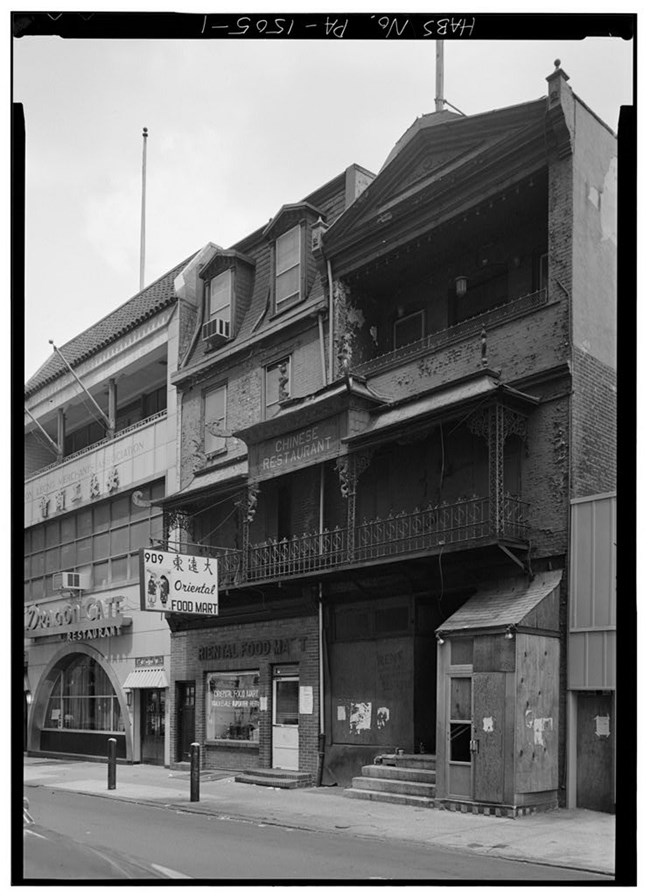Part of a series of articles titled Finding a Path Forward: Asian American Pacific Islander National Historic Landmarks Theme Study.
Article
Essay 7: Asian American Businesses, 1848 to 2015 Accommodation and Eclectic Innovation

Historic American Building Survey (HABS PA,51-PHILA,297--1) photo, in the collections of the Library of Congress (http://hdl.loc.gov/loc.pnp/hhh.pa0773/photos.137910p).
At first glance, the challenge of generating a comprehensive overview of Asian American businesses, from the 1840s to the present, seems daunting.[1] First, because such businesses were typically small-scale before World War II, and the documentary record in terms of detailed accounts about such enterprises in the published literature ranges from non-existent to slim. In addition, since Asian immigrants and their descendants made their way into most regions of the United States early on, both in terms of ethnic enclaves but also as independent entrepreneurs, most of their names and endeavors have been long and deeply buried.[2] What is more, the sheer numbers are staggering. One authority noted that, even over a decade ago, there were on the order of 1.1 million registered businesses owned by Asian Americans, encompassing marginal to global concerns.[3] By definition, then, and from the beginning, no short survey along the present lines can claim completeness. What is more, introducing some criteria for delimited the subject is imperative in order to make a survey manageable. My emphasis here in on the mainland United States, on "small" businesses, significant innovations they have introduced, and on the study of such enterprises vis-a-vis a "preservation" agenda.[4] Beyond this, the conceptual framework I rely upon here assumes a global perspective on the ties between Asia and the US. In this context, sojourning/immigration from Asia has to be framed in terms of the impact of "the West upon the rest," generally, and forced integration of Asian pre-industrial economic systems into the world system, specifically.
Concomitantly, as far as the term "innovation" is concerned, I do not mean "new configurations or applications of an idea, product, or strategy" -- i.e., the kind of definition often found in a standard dictionary. Rather, Asian American small businesses have to be understood vis-a-vis the many overt barriers that historically limited new Asian immigrants in the USA, especially before the war. Read more >> (.pdf 3.0MB)
[1] I would like to thank Professor Franklin Odo and his colleagues at the National Park Service for inviting me to write this essay. An earlier draft also benefitted from the suggestion of two anonymous reviewers.
[2] Occasionally, research surfaces on esoteric (and eccentric?) Asian pioneers in the United States who ventured off the beaten track and logged intriguing professional accomplishments. Japanese immigrant Frank Sakae Matrua, who from 1903 to 1913 opened his own studio and served as a photographer in and around Conconully, WA, Okanogan County. Although he passed away at only thirty-nine, many of Matsura's photographs of Euro-Americans, American Indian locals, and elite families, were preserved (Roe 1981). Reputed to be from an upper-class background in Japan, Matsura apparently eschewed the company of Issei compatriots.
Another intriguing case has to do with pre-war bands and orchestras of Filipinos, which were in effect early small businesses in terms of music and entertainment. For example, "The Manila Serenaders," made up of Filipino musicians, fielded an eighteen-person orchestra that toured the west, mid-west, and the south during the 1930s (Brown 2010).
[3] Min Zhou, "Self-Employment," Asian Americans: An Encyclopedia of Social, Cultural, Economic, and Political History, Vol. 3, edited by Xiaojian Zhao and Edward J. W. Park (Santa Barbara, CA: Greenwood, 2014), 985-988.
[4] A definition advanced by the Small Business Association is useful in terms of framing what constitutes such an enterprise. According to the SBA, a "small business concern" is one that is: "...independently owned and operated, not dominant in the field of operation in which it is bidding" (size standards, 13 CFR Pat. 131; FAR M. 122). Concomitantly, a "minority business operation" is one that is at least fifty-one percent owned, operated, or controlled on a daily basis by one or more US citizens of African, Asian, Latino, or Native/Alaskan ancestry. Although, clearly, the utilization of definitions along these lines, whether projected back in history or not, would entail excluding interesting cases which arguably are "Asian American small businesses," delimitation of some kind is necessary as everything simply cannot be covered here.
A commentary on methodology is also appropriate from the start. The approach I've developed here is tripartite. First, I have made free use of a number of encyclopedias about the Asian American experience, mainly because they are recently published, they encompass a wide range of the available literature, and details of ethnic-specific business practices are duly noted therein. Second, I have chosen to deploy a set of ideal types to organize this overview because so many of the entrepreneurial pursuits of the persons and families of Asian descent are similar in focus, then and now. Third, I have examined the published literature with an eye to best preserving the history of Asian Americans and innovation in small business, both in terms of the selection of establishments, but also in terms of how the latter might be best contextualized, imaginatively and productively.
The views and conclusions contained in the essays are those of the authors and should not be interpreted as representing the opinions or policies of the U.S. Government. Mention of trade names or commercial products does not constitute their endorsement by the U.S. Government.
Last updated: October 29, 2018
